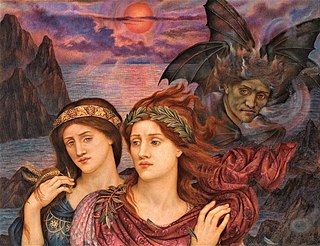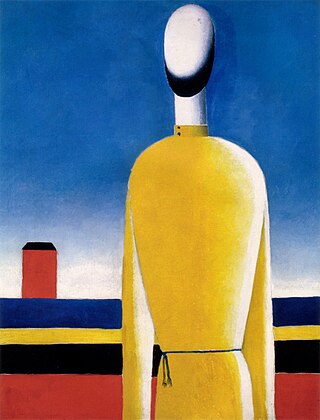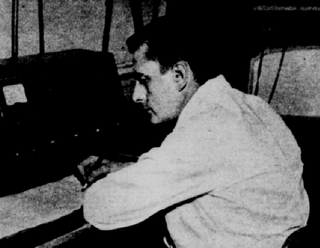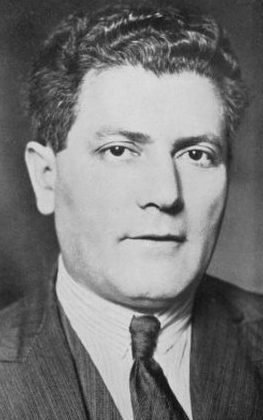Related Research Articles

Clairvoyance is the magical ability to gain information about an object, person, location, or physical event through extrasensory perception. Any person who is claimed to have such ability is said to be a clairvoyant.

Extrasensory perception or ESP, also called sixth sense, is a claimed paranormal ability pertaining to reception of information not gained through the recognized physical senses, but sensed with the mind. The term was adopted by Duke University psychologist J. B. Rhine to denote psychic abilities such as intuition, telepathy, psychometry, clairvoyance, clairaudience, clairsentience, empathy and their trans-temporal operation as precognition or retrocognition.

Parapsychology is the study of alleged psychic phenomena and other paranormal claims, for example, those related to near-death experiences, synchronicity, apparitional experiences, etc. Criticized as being a pseudoscience, the majority of mainstream scientists reject it. Parapsychology has also been criticised by mainstream critics for many of its practitioners claiming that their studies are plausible in spite of there being no convincing evidence for the existence of any psychic phenomena after more than a century of research.

Telepathy is the purported vicarious transmission of information from one person's mind to another's without using any known human sensory channels or physical interaction. The term was first coined in 1882 by the classical scholar Frederic W. H. Myers, a founder of the Society for Psychical Research (SPR), and has remained more popular than the earlier expression thought-transference.

Precognition is the purported psychic phenomenon of seeing, or otherwise becoming directly aware of, events in the future.

A ganzfeld experiment is an assessment used by parapsychologists that they contend can test for extrasensory perception (ESP) or telepathy. In these experiments, a "sender" attempts to mentally transmit an image to a "receiver" who is in a state of sensory deprivation. The receiver is normally asked to choose between a limited number of options for what the transmission was supposed to be and parapsychologists who propose that such telepathy is possible argue that rates of success above the expectation from randomness are evidence for ESP. Consistent, independent replication of ganzfeld experiments has not been achieved, and, in spite of strenuous arguments by parapsychologists to the contrary, there is no validated evidence accepted by the wider scientific community for the existence of any parapsychological phenomena. Ongoing parapsychology research using ganzfeld experiments has been criticized by independent reviewers as having the hallmarks of pseudoscience.
Remote viewing (RV) is the practice of seeking impressions about a distant or unseen subject, purportedly sensing with the mind. Typically a remote viewer is expected to give information about an object, event, person or location that is hidden from physical view and separated at some distance. Physicists Russell Targ and Harold Puthoff, parapsychology researchers at Stanford Research Institute (SRI), are generally credited with coining the term "remote viewing" to distinguish it from the closely related concept of clairvoyance. According to Targ, the term was first suggested by Ingo Swann in December 1971 during an experiment at the American Society for Psychical Research in New York City.

Helmut Schmidt was a German-born physicist and parapsychologist whose experiments on extrasensory perception were widely criticized for machine bias, methodological errors and lack of replication. Critics also noted that necessary precautions were not taken to rule out the possibility of fraud.
The Princeton Engineering Anomalies Research (PEAR) was a research program at Princeton University that studied parapsychology. Established in 1979 by then Dean of Engineering Robert G. Jahn, PEAR conducted formal studies on two primary subject areas, psychokinesis (PK) and remote viewing. Owing to the controversial nature of the subject matter, the program had a strained relationship with Princeton and was considered by the administration and some faculty to be an embarrassment to the university. Critics suggested that it lacked scientific rigor, used poor methodology, and misused statistics, and characterized it as pseudoscience. PEAR closed in February 2007, being incorporated into the "International Consciousness Research Laboratories" (ICRL).

Joseph Banks Rhine, usually known as J. B. Rhine, was an American botanist who founded parapsychology as a branch of psychology, founding the parapsychology lab at Duke University, the Journal of Parapsychology, the Foundation for Research on the Nature of Man, and the Parapsychological Association. Rhine wrote the books Extrasensory Perception and Parapsychology: Frontier Science of the Mind.
Montague Ullman was a psychiatrist, psychoanalyst and parapsychologist who founded the Dream Laboratory at the Maimonides Medical Center in Brooklyn, New York and for over three decades promoted public interest in dreams and dream sharing groups.

Stanley Krippner is an American psychologist and parapsychologist. He received a B.S. degree from the University of Wisconsin–Madison in 1954 and M.A. (1957) and Ph.D. (1961) degrees from Northwestern University.
Sensory leakage is a term used to refer to information that transferred to a person by conventional means during an experiment into ESP.

Samuel George Soal (1889–1975) was a British mathematician and parapsychologist. He was charged with fraudulent production of data in his work in parapsychology.

Nandor Fodor was a British and American parapsychologist, psychoanalyst, author and journalist of Hungarian origin.
In psychology, anomalistic psychology is the study of human behaviour and experience connected with what is often called the paranormal, with few assumptions made about the validity of the reported phenomena.

Extrasensory Perception is a 1934 book written by parapsychologist Joseph Banks Rhine, which discusses his research work at Duke University. Extrasensory perception is the ability to acquire information shielded from the senses, and the book was "of such a scope and of such promise as to revolutionize psychical research and to make its title literally a household phrase".

Charles Edward Mark Hansel was a British psychologist most notable for his criticism of parapsychological studies.

Leonid Leonidovich Vasiliev (1891–1966) was a Russian Soviet parapsychologist and physiologist.
Jule Eisenbud was an American psychiatrist, author and researcher known for his research into parapsychology.
References
- ↑ Krippner, Stanley; Franasso, Cheryl. (2011). Dreams, Telepathy, and Various States of Consciousness. NeuroQuantology 9 (1): 4.
- ↑ Wiseman, Richard. (2014). Night School: Wake Up to the Power of Sleep. Macmillan. p. 202. ISBN 978-1-4472-4840-8 Wiseman writes regarding Krippner and Ullman's experiments "Over the years, many researchers have failed to replicate their remarkable findings and, as a result, the work is seen as curious but not proof of the paranormal."
- 1 2 Hansel, C. E. M. (1989). The Search for Psychic Power: ESP and Parapsychology Revisited. Prometheus Books. pp. 141-152. ISBN 0-87975-516-4
- 1 2 3 Ullman, Montague (2003). "Dream telepathy: experimental and clinical findings". In Totton, Nick (ed.). Psychoanalysis and the paranormal: lands of darkness. Reference, Information and Interdisciplinary Subjects Series. Karnac Books. pp. 14–46. ISBN 978-1-85575-985-5.
- ↑ Devereux, George, ed. (1953). "The Eisenbud-Pederson-Krag-Fodor-Ellis Controversy". In Psychoanalysis and the Occult. Oxford, England: International Universities Press.
- 1 2 3 Eshel, Ofra (December 2006). "Where are you, my beloved?: On absence, loss, and the enigma of telepathic dreams". The International Journal of Psychoanalysis 87 (6): 1603–1627.
- ↑ Frieden, Ken (1990). Freud's dream of interpretation. SUNY series in modern Jewish literature and culture. SUNY Press. pp. 102-103. ISBN 978-0-7914-0124-8.
- ↑ Freud, S. Collected Papers, V. IV pp 408-435 International Psychoanalytic Library No. 7, Ed 1, Basic Books 1959 "Have I given you the impression that I am secretly inclined to support the reality of telepathy in the occult sense? If so, I should very much regret that it is so difficult to avoid giving such an impression. In reality, however, I was anxious to be strictly impartial. I have every reason to be so, for I have no opinion; I know nothing about it." p. 435. Here Freud explicitly refers to the conflation of telepathy as such with clairvoyance and other occult elements.
- ↑ Ellis, Albert. (1947). Telepathy and Psychoanalysis: A Critique of Recent Findings. Psychiatric Quarterly 21: 607-659.
- ↑ Ellis, Albert. (1949). Re-analysis of an alleged telepathic dream. Psychiatric Quarterly: 23: 116-126.
- ↑ Löfgren, L. B. (1968). Recent Publications on Parapsychology. Journal of the American Psychoanalytic Association 16: 146-178.
- ↑ McBroom, Patricia. (1967). Dreams, Art and Mental Telepathy. Science News 92: 424.
- ↑ Hansel, C. E. M. The Search for a Demonstration of ESP. In Paul Kurtz. (1985). A Skeptic's Handbook of Parapsychology. Prometheus Books. pp. 97-127. ISBN 0-87975-300-5
- ↑ Belvedere, E., Foulkes, D. (1971). Telepathy and Dreams: A Failure to Replicate. Perceptual and Motor Skills 33: 783–789.
- ↑ Sherwood, S. J; Roe, C. A. (2003). A Review of Dream ESP Studies Conducted Since the Maimonides Dream ESP Programme. Journal of Consciousness Studies, 10: 85-109.
- ↑ Alcock, James. (2003). Give the Null Hypothesis a Chance: Reasons to Remain Doubtful about the Existence of Psi. Journal of Consciousness Studies 10: 29-50. "In their article, Sherwood and Roe examine attempts to replicate the well-known Maimonides dream studies that began in the 1960s. They provide a good review of these studies of dream telepathy and clairvoyance, but if one thing emerges for me from their review, it is the extreme messiness of the data adduced. Lack of replication is rampant. While one would normally expect that continuing scientific scrutiny of a phenomenon should lead to stronger effect sizes as one learns more about the subject matter and refines the methodology, this is apparently not the case with this research."
- ↑ Wiseman, Richard. (2014). Night School: Wake Up to the Power of Sleep. Macmillan. pp. 200-201. ISBN 978-1-4472-4840-8